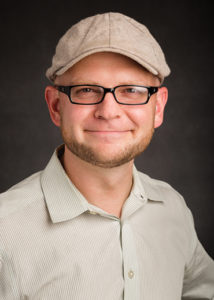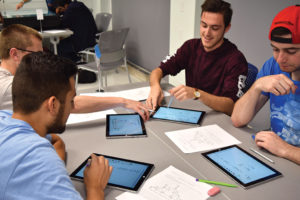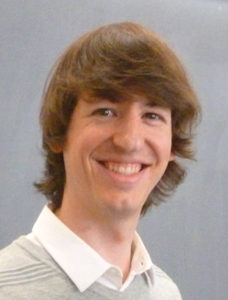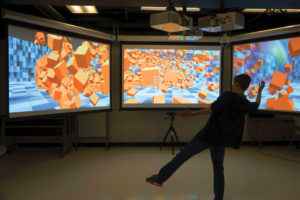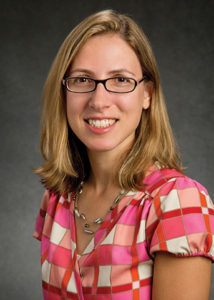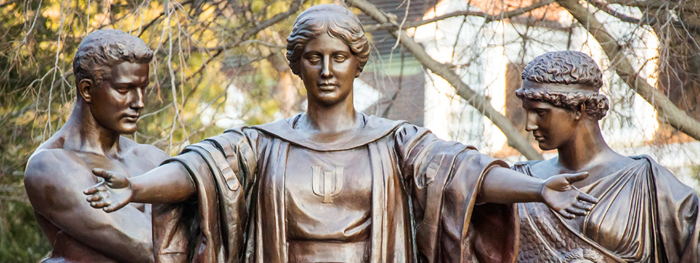Cyberlearning
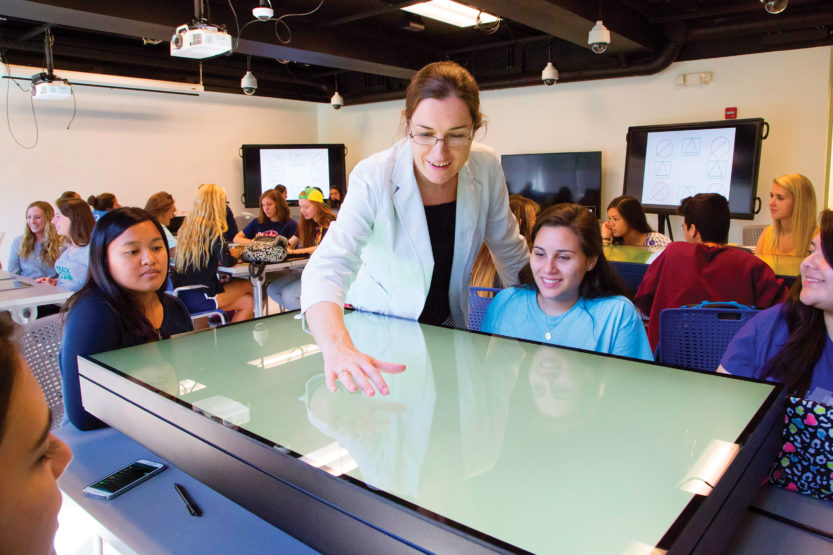 Assistant Professor Emma Mercier is the program chair of Digital Environments for Learning, Teaching & Agency (DELTA), which investigates the applications for technology-enhanced classrooms, mobile devices and immersive simulations. (Photo courtesy of Gina Manola)
Assistant Professor Emma Mercier is the program chair of Digital Environments for Learning, Teaching & Agency (DELTA), which investigates the applications for technology-enhanced classrooms, mobile devices and immersive simulations. (Photo courtesy of Gina Manola) Two little girls stand side by side in a virtually empty room, gleefully gyrating their arms. The room is “virtually” empty because the girls have a companion of sorts, a computer-simulated robot illuminated in high definition on one wall. Although their manner is playful, the girls have determined expressions on their faces, intent on completing a complex and urgent task. The robot is trapped in a factory that has caught fire, and the girls must help the robot escape by energizing it. Their motions control its movements, and the robot gives them verbal clues about what they need to do.
Through a one-way mirror in an adjacent room, Associate Professor Robb Lindgren and Assistant Professor Emma Mercier, Dept. of Curriculum and Instruction at Illinois, can observe the girls’ progress. For the girls, rescuing the robot is a game, similar to one they might play on a computer, but acted out on a screen so large, they are immersed in it. For Lindgren and Mercier, the game is a digital research tool, one that helps them advance their pioneering work in finding new and innovative ways to teach scientific concepts and to increase interest in science, technology, engineering and math (STEM).
While helping the robot, the girls are assimilating knowledge about how to store and use energy and taking a virtual step into the future of science education—a future that is unfolding rapidly in a space on the first floor of the College of Education building, near the intersection of Peabody and Sixth Street, where artificial intelligence, digital technology and educational research also intersect.
This space is the Illinois Digital Ecologies and Learning Laboratory (IDEALL), and it is equipped with a range of high-tech tools, including tablet computers, adjustable 80-inch, flat-screen TVs, multi-touch tabletop screens, and a sophisticated recording system with ceiling-mounted cameras and wireless microphones connected to local storage units for data collection. “IDEALL is a resource we use, along with other faculty members,” says Lindgren. “I don’t know of any other facility like it that exists for this purpose.”
Technology-enhanced learning
Four years ago, Lindgren and Mercier, both graduate students from Stanford University, were recruited and tasked with developing a program focused on technology-enhanced learning that would use advanced digital tools. Their tenure began shortly after the National Science Foundation signaled a new emphasis on using technology in education by launching an initiative called “Cyberlearning: Transforming Education,” with a goal to promote understanding and interest in STEM. Their colleague, Associate Professor Maya Israel, who had arrived at Illinois from the University of Cincinnati in 2012, was already exploring the use of digital technology in the Dept. of Special Education. Then in 2015, the College welcomed data scientist Luc Paquette from Columbia University as an assistant professor who could bring a computer-science component to the research mix.
Lindgren and Mercier gave their program the acronym DELTA (Digital Environments for Learning, Teaching & Agency). A digital environment is created through computer technology. The College raised funds to build IDEALL, which opened in September 2015, and also began offering an option for undergraduate and graduate students to earn an Education degree with a concentration in DELTA.
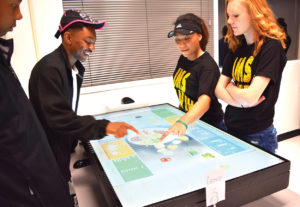
Students move different food items onto a virtual plate as part of Food for Thought, a touch-screen application that calculates each food’s cost, caloric value, and carbon and water footprint. (Photo courtesy of Luettea Mae Lawrence)
The four professors are involved in nine NSF-funded projects, along with teaching responsibilities that bring their students into the digital arena. “We all tackle digital issues from a different perspective,” says Lindgren, who last year was one of four Illinois faculty members selected to present his work to the University of Illinois Board of Trustees. “I approach things from the perspective of physical interactions, or what is called embodied learning; Emma looks at collaborations; Luc looks at data and data mining; Maya looks at the needs of struggling learners.”
Mercier, with research subjects ranging from 9-year-olds to graduate students, admits to having a lot on her plate. That is an apt cliché, because one of her projects involves an interactive touchscreen application that her lab team designed called Food for Thought, which measures caloric values, water and carbon footprints, and the costs of different foods as students move them onto a virtual plate. Not only does the app teach students about nutrition and how their food choices affect the environment, Mercier explains, it serves the underlying purpose of “helping them make sense of multiple forms of data.” The app has generated significant attention, and is available in the Apple store.
Mercier’s main focus is collaborative (group) learning. Educators know collaboration can work really well when it works, but it often doesn’t. “We know from research that collaboration is important, but students don’t get better at collaborating [because] you simply put them in groups,” says Mercier. “They need to have the resources, the social skills to engage with each other and a willingness to express what they don’t know.”
Mercier documented these challenges in an NSF-funded study of Illinois engineering students called C-STEPS (Collaboration Support Tools for Engineering Problem-Solving), in which students solved problems using sketching styluses on synched tablets that collected data related to their interactions. This Fall, Mercier and Paquette will begin to expand on that effort with C-STEPS2, a four-year NSF funded-study that will examine how digital tools can be used and improved to support collaborative problem-solving. Undertaken with Mariana Silva Sohn, a lecturer and curriculum development coordinator in the Dept. of Mechanical Science and Engineering at Illinois, the project will use the IDEALL space for a weekly engineering class meeting. Researchers will observe and record the behavior and interactions of these students and their teaching assistants, and possibly provide prompts to alert TAs when it might be helpful to intervene and support the work of different groups.
Using data mining to identify learning patterns
Paquette, who is already analyzing data collected in the first C-STEPS study, says this next iteration of the project will enable him to “align” data acquired through recorded observation in the IDEALL space with the data provided by the interactive surfaces the engineering students work on. By isolating and examining patterns, Paquette will help identify why and when the different groups’ collaborative efforts are—and are not—working.
A computer scientist who focuses on student behavior in digital environments, Paquette says his work is driven by a desire to learn the answer to a simple but essential question—and one that could take a lifetime of investigation: How do people think? He analyzes data for clues to unravel that mystery. “I’m interested in looking at how people interact with these learning environments and how we can infer what is going on in their minds—what their intentions are, what they have learned, what will help them learn in the future,” he says.
Paquette’s research has included mining data from Intelligent Tutoring Systems (ITS), an increasingly popular teaching tool in which interactive software substitutes for a live tutor. Paquette’s research examines how, when and why students try to “game” a system. Left to their own devices, some students figure out how to click through provided hints and quickly guess correct answers without actually learning them. Paquette, who is able to detect these types of behaviors, says, “Once we have that info, we can build models that recognize those behaviors, and they can be integrated into the system.”
He views the confluence of computer science and education at Illinois as a positive development. “It’s not just teamwork here,” he says. “It’s interdisciplinary teams that bring together people who have not traditionally talked to each other—computer scientists and education people. When you put people from different fields together, it has the potential to create exciting collaborations.”
Computer science and special education
Maya Israel is research director of the Creative Technology Research Lab (CTRL), the umbrella organization under which she conducts her research. Israel has two NSF projects focused on computing and computational thinking for students in grades K-12.
“My work centers around finding ways to make computer science and programming accessible and engaging for students at risk for academic failure,” she says. “There is a national movement to increase participation in STEM by people who traditionally do not enter these fields. This has generally focused on women and people from different cultural backgrounds. My focus is on finding ways to include people with disabilities in this work.”
At the classroom level, Israel is examining K-12 computer-science environments such as Lifelong Kindergarten’s Scratch, in which students create their own stories and animations. “Rather than just being consumers, kids are producers, [which is] empowering,” she says. To further her research, Israel and her students have developed the Collaborative Computing Observation Instrument (C-COI), a tool that can be used with video-screen-capture software to measure students’ computational and socialization behaviors, including time on a task, challenges they face, adaptive help-seeking and problem-solving. Israel is grateful for the collaboration she received from Champaign Unit 4 Schools, especially on pilot projects, while she waited to secure NSF funding. She also is working with the New York City school system, where there is a concerted push to increase student interest in STEM.
“In order to get kids to think about taking advanced computer science in high school, they must have success in earlier grades; instruction has to be engaging,” she says. “There are tons of jobs in this area. If you have the skills to code or program, you have good career options. Beyond that, there are inherently useful things about learning computer science.”
Learning through embodiment
As artificial intelligence and virtual reality move into the education realm, they present an opportunity to lay the groundwork for future learning. In this context, the work that Lindgren is doing with his team could be seen as opportunistic.
“One problem with traditional teaching methods is that we position students as outsiders—‘Come into this lab and let me show you how things work,’” Lindgren says. “Computer simulations and immersive technologies invite students inside in a way that allows them to see themselves as potential scientists and engineers. They are manipulating and interacting with ideas in important ways that I think makes them feel like it’s something they can do. We want to provide that experience—particularly to students who have historically struggled to identify with STEM.”
Another Lindgren project, ELASTICS (Embodied Learning Augmented through Simulation Theaters for Interacting with Cross-Cutting Concepts in Science), involves full-body movement—getting high-school students to use their arms and legs to control different simulations as a way to understand big-picture concepts. Conducted in collaboration with the Illinois Informatics Institute and the National Center for Supercomputer Applications, where Lindgren also
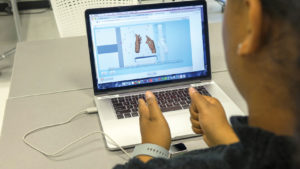
Students use whole-body movements to control simulations in an ELASTICS virtual-reality environment.
holds an appointment, the ELASTICS study makes full use of the IDEALL space. “One of the great things about these embodied simulations is that they appear to equally engage girls and boys,” Lindgren says. “Whereas traditional video game platforms tend to be more appealing to boys.”
One unmistakable quality the four faculty members share is a cheerful patience when explaining the highly technical, and at times esoteric, terminology of their research. Whether it’s Paquette, who sometimes ends his sentences with a cautious interrogatory “Right?” to make sure you’re following him, or Israel, who can put a neophyte at ease by answering questions with a reassuring “Yup,” they all convey an enthusiasm for their work that likely resonates with their students. It underlines their sense of optimism that the work they’re doing will lead to a better understanding of how to teach STEM topics and eventually make those concepts accessible to future learners.

